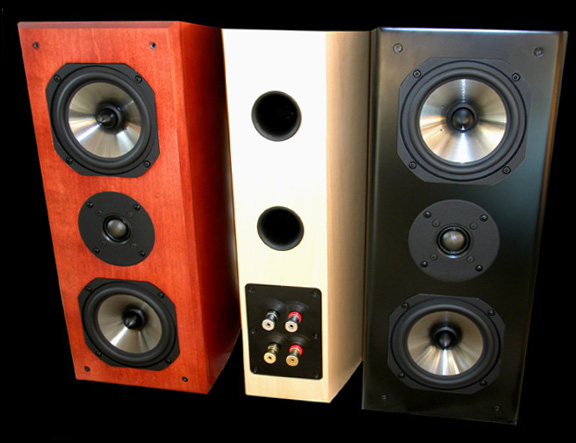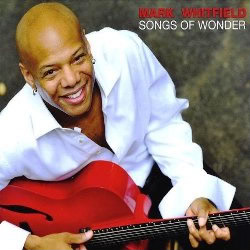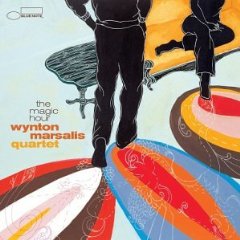Van L. Speakerworks Quartet loudspeakers
| Van L. Speakerworks Quartet loudspeakers |
| High End performance from Chicago’s North side |
|
|
|
April 2009 |

Why Van L. Speakerworks?
I ran into one of my old audiophile “runnin’ buddies,” Roger Swiatek, at last year’s CES, and we talked about some of our favorite audio hang outs from “back in the day,” as the kids like to say. One of the shops that Roger mentioned was a place located just a few miles north of Wrigley Field called Chicago Speakerworks. I told Roger that I used to hang out there too, but I was there for car stereo equipment back in my high-end car audio days. He told me that the shop was still there but that it had changed its name and that they were now making their own loudspeakers, to boot.
Roger said he had heard their speakers and felt them to be a serious enough product to warrant a critical review. I became even more intrigued when he told me that, the person who had purchased the shop was none other than long-time Chicago Speakerworks salesman and speaker designer, John Van Leishout (John Van to friends) , and the new name of the store was Van L Speakerworks.
I have known Leishout for some time and had always found him to be a great guy to talk to who possessed a wealth of knowledge about loudspeaker design. He was one of the few dealers who would let me take home gear without any kind of a hassle. John was a bit of a maverick too. While CJ and ARC were dominating the tube amp marketplace, he was one of the first guys in the area to bring in gear from companies such as VTL, Berning and CAT. Leishout was one of those guys who always seemed to have speakers in the back of the shop in various stages of completion, so it was great to learn that he had finally built one that was ready for prime time.
I followed up on Roger’s suggestion and made the trip into the city to see Leishout and ask about reviewing a pair of his speakers. Upon my arrival, I noticed two distinct things. The first of course was name change. I didn’t bother to ask him why because I knew what he would say: “I could have called it Van Leishout Speakerworks but I figured that everyone would just butcher the name.” The other thing that caught my attention was the sound of the speakers playing in his main listening room. The system was driven by an old Berning TF-10 preamplifier paired with a Berning EA-2100 amplifier. Leishout invited me to come in and give his latest speaker creation a listen. As I sat and listened, I discovered two things. First, Leishout still loves tube equipment, and second, he had become a true high-end speaker designer. I saw several pairs of speakers in the room and asked him which ones I would be doing the review on. He pointed to the speaker system that was playing. It was called the Quartet.
The Van L. Speakerworks Quartet
Leishout and I spent an hour talking about the Quartet and arranged a time for him to deliver and set them up in my home. A few weeks later, Leishout arrived with the Quartets and a pair of stands. We played a little music to make sure that they were working properly and after some minor tweaking and playing around with placement, I was ready to begin my evaluation. The Quartet is a stand mounted speaker measuring 20” H X 8” W X 14” deep. Its driver compliment consists of two titanium/polypropylene 5.25” mid-woofers with a Scanspeak liquid cooled, dual chamber tweeter in a D’Appolito configuration. The mid-woofers are designed by John and made here in the United States. The speaker’s frequency response is rated from 45-30 kHz at +/- 3 dB. They present a relatively easy load of 90 dB at 8 Ohms. The Quartets finishes include piano black, cherry and maple. The Quartet is very well made and possesses craftsmanship and an attention to detail usually reserved for speakers several times their cost. Parts quality used in the crossover and the drivers used here are also something usually reserved for speakers 3-4 times their cost. The front baffle is finished in the same material as on the top and sides. This contributes greatly to the speaker’s attractive looks.
Back to the crossover for a moment. I knew Leishout to be someone who always felt that the key to any good loudspeaker design was the crossover. So I asked him to explain what went into the design of the Quartet’s crossover. “It is a serious 1st order design with only 4 high-quality elements in the signal path. Parts include Alpha-Core inductors, Clarity capacitors and Caddock resistors, parts typically found in speakers selling for $15,000 and up. During assembly of the crossover, all contact points are first crimped, then soldered with WBT lead-free silver. All wiring is point-to-point (no circuit boards). All crossover elements are rubber mounted to isolate them from the cabinet for improved dynamics and clarity.”
The Quartet uses WBT NextGen copper binding posts, though silver is offered as an option. Like earlier Van L. designs the Quartet uses ambient recovery technology. There is more information on this neat little technology on the Van L. Speakerworks website, but in short, this system allows the listener to adjust the soundstage to get the effect of what John Van Leishout feels is a “live representation of the music.” Though I did listen to the speakers with this enhancement in place, I wasn’t sure I was comfortable with the effect, so almost all of my listening was done without it.
So what did the Quartet sound like?
I was extremely impressed by what I saw and heard from the Quartet. All the little details that you sometimes take for granted are all brought to the forefront here. Construction quality is highlighted by clean lines, no unequal gaps, and outstanding finish for a $3k loudspeaker. Even more impressive though was the sound quality. The Quartet is smooth and relaxed, and reveals a huge soundstage that had no difficulty exceeding the rear boundaries of my 16’ X 25’ foot room. Stage width was beyond my walls and vocals were portrayed accurately between the speakers. I could tell when someone was seated on a stool, a chair or just standing. The speakers are slightly on the warm side of neutral which lends a natural, comfortable tone to the music, and enhanced my enjoyment of live jazz and vocal works. The sonic images appeared to be coming from a stage thrown behind the speakers and gave me the feeling that I was experiencing music in one of my favorite jazz clubs or music venues. The speakers also do very well with even pop and R&B music. A combination of tight deep bass and a lively upper bass, made me want to bob my head and tap my toes when up tempo music began to play. With its spacious staging capabilities, the Quartet does very well with classical music, especially with orchestral string music, but don’t expect them to pressurize your room with the lowest notes from your favorite organ recordings. The high frequencies are done very well, always sounding airy and detailed and having not a hint of stridency or harshness. The Quartet’s drivers are fast and reveal a good amount of detail and resolution and do a good job in their handling of transients.
 On guitarist Mark Whitfield’s tribute to the blues, True Blue[Verve], his impressive speed and pizzicato attacks on the strings are handled with aplomb by the Quartet. The Quartet’s handling of tempo and dynamics on Manu Katche’s Neighborhood [ECM] was also no less than impressive. Pianist Marcin Wasilewski’s accompaniment on this disc is both lyrical and smooth.
On guitarist Mark Whitfield’s tribute to the blues, True Blue[Verve], his impressive speed and pizzicato attacks on the strings are handled with aplomb by the Quartet. The Quartet’s handling of tempo and dynamics on Manu Katche’s Neighborhood [ECM] was also no less than impressive. Pianist Marcin Wasilewski’s accompaniment on this disc is both lyrical and smooth.
The Quartet’s performance with Danny Caron’s CD Good Hands [Danny Caron Music] would be noteworthy enough if just based on his guitar playing alone. If you take into account how zesty and funky Jim Pugh’s Hammond B-3 playing is on this disc, you have a CD that really swings and draws you completely into an enjoyable performance. On the Branford Marsalis Quartet CD Eternal, the contemplative “Dinner for One Please, James” gives us another side of Branford’s formidable saxophone playing. Here his tone and approach caught my attention as I felt a bit of melancholy portrayed in this work.
 Sticking with the Marsalis’ theme, the Wynton Marsalis Quartet CD The Magic Hour[Blue Note] did an excellent job of showing off the Quartet’s considerable, wall to wall, imaging capabilities. Track after track revealed stage reproduction that was quite wide and deep with seemingly three dimensional performers in their own airy space. As expected, the Quartets did a good job with vocals as well. The Brazilian duo Two for Brazil’s CD Goes to the Movies [Jazzmin Records] contains a delightful selection, ‘Samba Saravah’. This is a pleasantly warm duet performed by Judy Roberts and Paulinho Garcia that has a ‘lifelike’ presence to it.
Sticking with the Marsalis’ theme, the Wynton Marsalis Quartet CD The Magic Hour[Blue Note] did an excellent job of showing off the Quartet’s considerable, wall to wall, imaging capabilities. Track after track revealed stage reproduction that was quite wide and deep with seemingly three dimensional performers in their own airy space. As expected, the Quartets did a good job with vocals as well. The Brazilian duo Two for Brazil’s CD Goes to the Movies [Jazzmin Records] contains a delightful selection, ‘Samba Saravah’. This is a pleasantly warm duet performed by Judy Roberts and Paulinho Garcia that has a ‘lifelike’ presence to it.
Winding things up
I couldn’t help but be impressed by what John Van Leishout was able to accomplish with the Quartet, especially at the magical $3,000 price point. I have reviewed several speakers at that price, my favorites being the LSA Group’s LSA2s and the Almarro Audio M2As. The M2As have a magical quality in their midrange performance that if you put forth the time and effort to set them up to get the best out of them, high rewards are to be realized. The Quartet, on the other hand, is easier to setup and offers you wonderful music almost right out of the box and offer up better midrange and imaging qualities. The bass performance of the two speakers is comparable with the M2As possessing the slightly deeper bass, but the low end performance of the Quartet being livelier, fuller and more exciting. The LSA2s sound closer to the Quartet but has a slight boxy coloration that the Quartet does not.
There are a lot of competitors for speakers at this price point, but few of them have as much to offer in terms of build, parts quality, and performance of the Van L. Speakerworks Quartet. They have been a joy to listen to. If you’re looking for a speaker in the $3,000 range, whose performance is comparable to speakers at 2-3 times its price, then the Quartet deserves to be on your shortlist. For their cost to construction ratio alone, these speakers are a bargain. But when you consider their musical performance, they simply are “highly recommended.”

![]()
Specifications
Frequency response: 45-30kHz +/- 3db
Impedence: 8 ohms
Efficiency: 90dB
Measurements: 20″ h x 8″w x 14″ deep
Weight: 35lbs. each
Price: $2,995/pair
Manufacturer
Van L. Speakerworks
5704 N. Western Ave.
Chicago, Illinois 60659
Ph: 773-769-0773
Email: johnvanl@sbcglobal.net
Website: www.vanlspeakerworks.com
![]()
Don’t forget to bookmark us! (CTRL-SHFT-D)
Stereo Times Masthead
Publisher/Founder
Clement Perry
Editor
Dave Thomas
Senior Editors
Frank Alles, Mike Girardi, Key Kim, Russell Lichter, Terry London, Moreno Mitchell, Paul Szabady, Bill Wells, Mike Wright, Stephen Yan, and Rob Dockery
Current Contributors
David Abramson, Tim Barrall, Dave Allison, Ron Cook, Lewis Dardick, Dan Secula, Don Shaulis, Greg Simmons, Eric Teh, Greg Voth, Richard Willie, Ed Van Winkle, and Rob Dockery
Music Reviewers:
Carlos Sanchez, John Jonczyk, John Sprung and Russell Lichter
Site Management Clement Perry
Ad Designer: Martin Perry





Be the first to comment on: Van L. Speakerworks Quartet loudspeakers